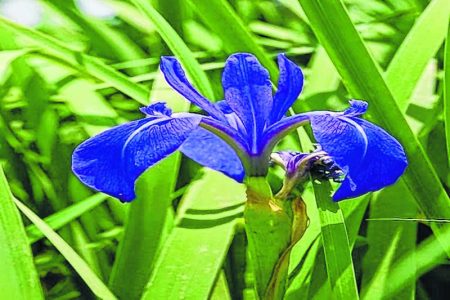IMPHAL, Apr 25 : Kombirei is one variety of flower which is closely associated with the history of Manipur but it is on the verge of complete disappearance from the soil of Manipur, according to CSIR-NEIST Principal Scientist Dr Huidrom Birkumar.
 Speaking to media persons at their Lamphelpat office yesterday, Dr Birkumar underscored the growing need to take up concrete protective measures in order to conserve Kombirei.
Speaking to media persons at their Lamphelpat office yesterday, Dr Birkumar underscored the growing need to take up concrete protective measures in order to conserve Kombirei.
In Manipur, Kombirei flowers are found at Lamphelpat, Yaralpat and Komlakhong.
All the species except one (the true Manipuri Kombirei) are believed to be introduced to Manipur in recent times. The one species of Kombirei that has been grown in Manipur since ages and associated with legends, art and culture of Manipur was earlier mistakenly cited as Iris bakeri Wall but the species does not exist in the list of Iris found in the world.
Now the scientific/botanical name of the traditional Manipuri Kombirei has been identified as Iris laevigata Fisch and it has been authenticated through Royal Botanical Garden, London.
Naturally, this species of Kombirei thrives well in wet or marshy areas.
Iris laevigata Fisch is found in Russia, Siberia, Japan, some countries of South East Asia and Manipur.
Even though Kombirei was seen blooming elegantly and abundantly at Lamphelpat and Yaralpat some years back, the flower has become very rare nowadays.
Given such grim situation, the authority concerned needs to take up some measures in order to protect the places where Kombirei thrives.
Although Kombirei is generally believed to be growing at Lamphelpat and Yaralpat, it has also been found around Loktak lake, more precisely at Komlakhong.
A scientific research would be conducted to ascertain why Kombirei thrives at Komlakhong, Dr Birkumar said. It is possible that Kombirei seeds are brought down by river currents into Loktak Lake before they germinate and grow in the surrounding areas.
Kombirei species found on land can produce 15 saplings in a year but Iris laevigata Fisch produce far lesser number of saplings.
It is crucial to protect the natural habitats of Kombirei if this variety of flower must be conserved, Dr Birkumar said.
He said that four species of Kombirei are found in Manipur.
Source: The Sangai Express



